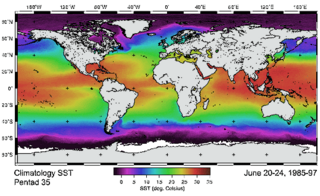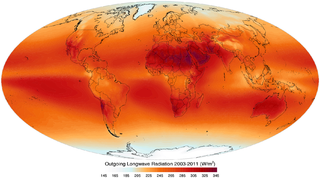
The greenhouse effect is a process that occurs when energy from a planet's host star goes through its atmosphere and warms the planet's surface, but the atmosphere prevents the heat from returning directly to space, resulting in a warmer planet. Light arriving from our Sun passes through Earth's atmosphere and warms its surface. The warmed surface then radiates heat, which is absorbed by greenhouse gases such as carbon dioxide. Without the natural greenhouse effect, Earth's average temperature would be well below freezing. Current human-caused increases in greenhouse gases trap greater amounts of heat, causing the Earth to grow warmer over time.

Satellite temperature measurements are inferences of the temperature of the atmosphere at various altitudes as well as sea and land surface temperatures obtained from radiometric measurements by satellites. These measurements can be used to locate weather fronts, monitor the El Niño-Southern Oscillation, determine the strength of tropical cyclones, study urban heat islands and monitor the global climate. Wildfires, volcanos, and industrial hot spots can also be found via thermal imaging from weather satellites. They can also be used as part of instrumental temperature records of Earth's climate system.

Numerical climate models use quantitative methods to simulate the interactions of the important drivers of climate, including atmosphere, oceans, land surface and ice. They are used for a variety of purposes from study of the dynamics of the climate system to projections of future climate. Climate models may also be qualitative models and also narratives, largely descriptive, of possible futures.

Climatology or climate science is the scientific study of Earth's climate, typically defined as weather conditions averaged over a period of at least 30 years. This modern field of study is regarded as a branch of the atmospheric sciences and a subfield of physical geography, which is one of the Earth sciences. Climatology now includes aspects of oceanography and biogeochemistry.

A general circulation model (GCM) is a type of climate model. It employs a mathematical model of the general circulation of a planetary atmosphere or ocean. It uses the Navier–Stokes equations on a rotating sphere with thermodynamic terms for various energy sources. These equations are the basis for computer programs used to simulate the Earth's atmosphere or oceans. Atmospheric and oceanic GCMs are key components along with sea ice and land-surface components.
Radiative transfer is the physical phenomenon of energy transfer in the form of electromagnetic radiation. The propagation of radiation through a medium is affected by absorption, emission, and scattering processes. The equation of radiative transfer describes these interactions mathematically. Equations of radiative transfer have application in a wide variety of subjects including optics, astrophysics, atmospheric science, and remote sensing. Analytic solutions to the radiative transfer equation (RTE) exist for simple cases but for more realistic media, with complex multiple scattering effects, numerical methods are required. The present article is largely focused on the condition of radiative equilibrium.
David L. Fried was an American scientist, best known for his contributions to optics. Fried described what has come to be known as the Fried Parameter, or r0. The Fried Parameter is a measure of the strength of the turbulence in the atmosphere of Earth. The turbulence causes what is known as seeing in astronomy and usually limits the optical resolution of ground-based telescopes and the detail in their images of astronomical objects. The Fried Parameter describes the smallest diameter of a telescope aperture at which the image fidelity starts to suffer significantly from turbulent airflows in the atmosphere of Earth. The Fried Parameter may change quickly on the time scale of minutes, or less. Typical values for the Fried Parameter in the visible spectrum may range from less than one centimeter to some tens of centimeters at good astronomical sites.

The Advanced Very-High-Resolution Radiometer (AVHRR) instrument is a space-borne sensor that measures the reflectance of the Earth in five spectral bands that are relatively wide by today's standards. AVHRR instruments are or have been carried by the National Oceanic and Atmospheric Administration (NOAA) family of polar orbiting platforms (POES) and European MetOp satellites. The instrument scans several channels; two are centered on the red (0.6 micrometres) and near-infrared (0.9 micrometres) regions, a third one is located around 3.5 micrometres, and another two the thermal radiation emitted by the planet, around 11 and 12 micrometres.

Outgoing Long-wave Radiation (OLR) is electromagnetic radiation of wavelengths from 3–100 μm emitted from Earth and its atmosphere out to space in the form of thermal radiation. It is also referred to as up-welling long-wave radiation and terrestrial long-wave flux, among others. The flux of energy transported by outgoing long-wave radiation is measured in W/m2. In the Earth's climate system, long-wave radiation involves processes of absorption, scattering, and emissions from atmospheric gases, aerosols, clouds and the surface.
An atmospheric radiative transfer model, code, or simulator calculates radiative transfer of electromagnetic radiation through a planetary atmosphere.
Streamer is a radiative transfer code to calculate radiances (intensities) or irradiances in the atmosphere.
6SV1 is an advanced radiative transfer code designed to simulate the reflection of solar radiation by a coupled atmosphere-surface system for a wide range of atmospheric, spectral and geometrical conditions. It belongs to the group of procedures called Atmospheric correction for the process of removing the effects of the atmosphere on the reflectance values of images taken by satellite or airborne sensors. The code operates on the basis of an SOS method and accounts for the polarization of radiation in the atmosphere through the calculation of the Q and U components of the Stokes vector. It is a basic code for the calculation of look-up tables in the MODIS atmospheric correction algorithm.
DISORT - general and versatile plane-parallel radiative transfer program applicable to problems from the ultraviolet to the radar regions of the electromagnetic spectrum.
4A/OP or, Automatized Atmospheric Absorption Atlas, is an operational fast and accurate radiative transfer model for the infrared.
In models of radiative transfer, the two-stream approximation is a discrete ordinate approximation in which radiation propagating along only two discrete directions is considered. It was first used by Arthur Schuster in 1905. The two ordinates are chosen such that the model captures the essence of radiative transport in light scattering atmospheres. A practical benefit of the approach is that it reduces the computational cost of integrating the radiative transfer equation. The two-stream approximation is commonly used in parameterizations of radiative transport in global circulation models and in weather forecasting models, such as the WRF. There is a large number of applications of the two-stream approximation, including variants such as the Kubelka-Munk approximation. It is the simplest approximation that can be used to explain common observations inexplicable by single-scattering arguments, such as the brightness and color of the clear sky, the brightness of clouds, the whiteness of a glass of milk, and the darkening of sand upon wetting. The two-stream approximation comes in many variants, including the Eddington approximation, as well as the modified Eddington, Quadrature, and Hemispheric constant models. Mathematical descriptions of the two-stream approximation are given in several books.
Codes for electromagnetic scattering by spheres - this article list codes for electromagnetic scattering by a homogeneous sphere, layered sphere, and cluster of spheres.
RTTOV - the fast radiative transfer model for calculations of radiances for satellite infrared or microwave nadir scanning radiometers.
The Community Radiative Transfer Model (CRTM) is a fast radiative transfer model for calculations of radiances for satellite infrared or microwave radiometers.
Atmospheric lidar is a class of instruments that uses laser light to study atmospheric properties from the ground up to the top of the atmosphere. Such instruments have been used to study, among other, atmospheric gases, aerosols, clouds, and temperature.
The skin temperature of an atmosphere is the temperature of a hypothetical thin layer high in the atmosphere that is transparent to incident solar radiation and partially absorbing of infrared radiation from the planet. It provides an approximation for the temperature of the tropopause on terrestrial planets with greenhouse gases present in their atmospheres.
Jin, Z., T.P. Charlock, K. Rutledge, K. Stamnes, and Y. Wang, An analytical solution of radiative transfer in the coupled atmosphere-ocean system with rough surface. Appl. Opt., 45, 7443-7455, 2006.
Jin, Z., and K. Stamnes, Radiative transfer in nonuniformly refracting layered media: atmosphere-ocean system, Appl. Opt., 33, 431-442, 1994.






